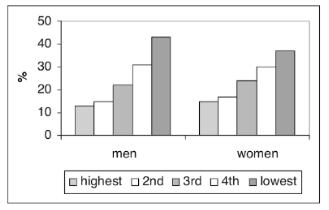Being healthy is everyone’s wish. But in the society of millions of people around you, living with good health is not at all an easy task. In today’s world, health inequalities are a big issue. You may raise a question that what are these health inequalities all about?. To clarify this we will say that avoidable and unjust differences in the health of the general public are termed as health inequalities. There are a few writers especially form North America. These writers use inequalities to create a distinction among crowds. They use inequities to denote unjust distinction among the group. Therefore, inequality is the most common term when we are talking about health inequalities.
Health inequalities are avoidable and that is the reason that it goes opposite to the policies of social justice. They don’t happen coincidentally or randomly. Circumstances determined them socially that are any control over it by any individual. And these are the circumstances that are responsible for not giving any advantages to the people and also restricting the chances of any individual to live a longer life. For more guidance on assignments related to health and nursing, you can visit assignment help
When we are saying that the health inequalities exits in UK, it means that each and every individual is not enjoying good highest quality standards of health in the country.
Introduction
Various characteristics of various social classes have changed over the most recent couple of years since society has changed, and the division between the diverse classes is likely not as clear as they used to be. However, individuals’ way of life, opportunities, behaviour and choices are as still possible to discover several different ways which are still impacted by the social class.
Reducing health-related abnormalities are always kept as a health gain as a central government policy point. Reducing
Health Inequalities in England
(As per the public health profile released by Public Health England (PHE)). In the year 2018, although there are some improvements that have been made in the sector of Health. But apart from improvements, stark health inequalities are still there and most of them are increasing.
Public Health England (PHE) has distributed its wellbeing profile of England for 2018. It joins knowledge and data to give a review of public wellbeing in England. Health disparities have some portion of their health profile, which they characterize as an inappropriate, avoidable difference in wellbeing conditions among groups of individuals.
Background
In the current era, there is a lot of progress in medical technology and after its expansion, there is a lot of improvement in the overall health of society. Even though there is still a lot of inequality in the sector of health care and still there are a lot of people who don’t have access to health facilities.
Purpose
The purpose of our article is to know about the disparities and challenges of health care. It tries to get knowledge and explain the mechanism underlying mechanism. It can be observed between the quality of health and socio-economic statuses.
This also investigates the paths of life that affect the likelihood of a person’s healthy life as well as the advantages and disadvantages that can affect health in adulthood from a young age. Apart from this, other factors like ethnicity, mental illness, disability and gender, will also be discussed as they also have a major contribution to disparities in health.
The United Kingdom is a country of high-salary where overall health is very good and prosperity is also high, and all these have been achieved without any inequalities on health and UK can be an example for other parts of the world who are thinking to implement the same measures for the betterment of health condition in their country. Assignment expert will help you in giving guidance in your health-related assignments.

Affordable Health Care
Inequality during the 19th century was major because of factors like insufficient treatments, overcrowding and poor sanitation. In the current era, in the society of industries, these losses have essentially vanished. Treatment centres and modern hospitals are now available throughout the UK. But not all of the individual can manage the treatment.
In 2004 a study was done that has shown that wealth is related to longevity, which exhibits a strong relationship between socio-economic status and mortality rates. For example, Figure 1 shows a design of health in income groups in England in 2004. As we can see from

It may be clarified by examining the benefits that individuals of high financial groups have. These advantages can assist better data knowledge about their health and care accessible through better training, or better congruity of consideration without issues of example, treatment regimens, for example costly medication.
Let’s take a case that, an individual with high pay and high level of education will probably have improved health protection, data about the accessibility of treatment will increment and more visits to the doctor. It can mean all the more screening, for example, screenings for diabetes
and colorectal cancer.
Child health inequalities
Just as the trend of health inequality, a complete public health profile surveys trend, for example, the real reasons for death, risk factor, morbidity and present and developing health-security issues. The disparity in kid’s weight has additionally expanded among the most deprived zones and ethnic gatherings.
Compared with the least deprived territories, the number of kids having issues of overweight is more in the deprived area around 1.8 times high. In kids between 10-11yrs, kids in dark African and Black Caribbean ethnic groups were overweight.

Materialist Framework
The materialist structure looks at the objective life states of individuals living regarding health and poverty. The materialistic state of poverty-related life forced to have social problems, social problems, development problems, and physical problems. Model of Neo-materialist clarifies the connection between income inequality and population health.
The essential premise of the life course approach is that individuals with past social experience influence their body’s physiology and pathology. Thusly, this model demonstrates that in
The principle motivation behind life course researchers is to see whether the distinction in health among individuals in various gatherings is because of the adverse conditions of a previous life.
What is social inequalities in health and environment?
Social inequalities, for instance, education, employment, relevant Income, also differences in demographics like sexual orientation or age, connect to unequal risks to factors. They add to health inequalities and frequently put the deprived groups at more serious risk for natural health impacts. In the EU alone, about 80 million individuals are living in relative destitution. A significant number of these live in sodden houses, with lacking warming and deficient sterile gear.
Conclusion
Inequalities in
Variables adding to life quality, for example, access to social class, ethnicity, sex, health care, ethnicity and health care. In recent time, projects have been begun to help improve health services in the UK, like by checking the decency of its services. As I would see it, regardless of the UK’s present inequalities, which is one of the main health care services on the planet, but these inequalities can be improved by further improvement and understanding, which have recently been evaluated. If you are looking for any help in assignments related to health and nursing, Law Assignment Help will
